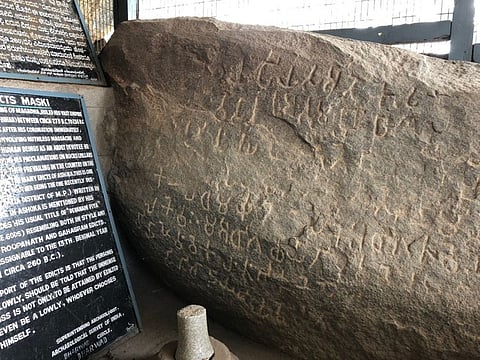India: Exploring Ashoka’s little known edict and seeing how it is still relevant today
One of greatest emperors, not for his military might, but for hearts & minds he conquered

Bengaluru: He united vast swaths of the Indian subcontinent into a single entity more than two millennia back. An achievement he accomplished not just through his sheer strength of authority and charisma, but also the enduring principles upon which Ashoka founded his empire - mutual respect, love and peace.
Known to the world as one of the greatest emperor’s of India, there is a reason why people remember the third Mauryan emperor as Ashoka the Great. His greatness lies in his renunciation of hate and prejudice and proclamation of love for all!
Etched in stone, his messages of peace and harmony are still there for all to see and follow, giving us a glimpse into the sort of India Ashoka envisioned.
Maski edict
Off the Karnataka State Highway 14, just a few kilometres from the town of Maski lie one of Ashoka’s most significant ancient inscriptions.
Known as the Maski Edict of Emperor Ashoka, the significance of these inscriptions, found on an isolated rock formation, can be ascertained by the fact that these unassuming ancient codes helped archeologists link dozens of other similar inscriptions to the third Mauryan Emperor.
Hundreds of kilometres away from Ashoka’s capital Pataliputra, bereft of any royal trappings or signs of a civilisation, the edict shows the reach of the emperor.
Located under a giant boulder, surrounded by wilderness, it is hard to imagine if anyone cared for or read these hardly legible words.
Nevertheless, their presence and survival through more than two thousand years suggest that a sophisticated civilisation certainly thrived in the vicinity and that the emperor held sway over the hearts and minds of people in the far corners of his domain.
Overtime, as rivers shift, weather patterns and lifestyles change, so do human habitats. Rise and fall of civilisations have been the order of history and no human habitat escapes the grip of Time. Only human goodness survives through all the debris of Time and Space.
These inscriptions ‘etched in stone’ clearly suggest the universality and eternal resonance of the human bond.
Ashokan edicts, revolving around the recurring themes of ‘peace, love and togetherness,’ have been discovered all across South Asia, before and after the discovery of Maski Edict.
Treasure hunt
The Maski Edict was discovered in 1915 by C. Beadon, a British gold-mining engineer who was on an expedition to unearth gold deposits in the rocky terrains of Karnataka’s Raichur district. He did strike gold but not of the type he was looking for, but something of a far greater significance!
Though, the Maski Edict and some of the other Ashokan edicts are in Brahmi script, his inscriptions are also found in the Kharosthi script of Prakrit as well as in Greek and Aramaic languages. This signifies Ashoka’s appreciation of diversity in cultures and languages, with his messages resonating as far away as the Greek and Hellenistic societies.
Both the Brahmi and Khorasthi (written right to left like Arabic, Persian and Urdu) scripts of Prakrit became extinct by fifth century CE.
Ashoka reigned over much of South Asia from 268 BCE to 232 BCE.
The Ashokan Edicts were deciphered in stages, first by Norwegian scholar Christian Lassen and later by British archeologist and historian, James Prinsep, in association with Major Cunningham in mid-19th century.
More than 30 of these edicts have been found on pillars, boulders and cave walls in different parts of modern India, Pakistan, Bangladesh, Afghanistan and Nepal, with all these countries forming a single stream of humanity practising different ways and understandings of life.
Ashoka began circulating these edicts of ‘peaceful co-existence’ when he gave up the path of violence and confrontation, adopting a life of righteousness that embodied appreciation and understanding of diverse faiths and cultures.
Finding peace
Following the way of Buddha, he came to understand the futility of focusing on the differences and appreciated the common strands that bind different groups of people together. It is obvious that his experience in long years of bloody warfare made him realise the folly of using power to dominate each other. Thus began his quest to win hearts through love!
Clearly, his experiences were not much different from what we come across in the modern world and the lessons he derived from those experiences could be as appropriate today as they were more than two millennia back.
Though, modern India has proudly adopted the symbols of Ashokan power and authority such as the ‘lion capital,’ which is India’s national emblem, and the Ashoka Chakra that adorns the Indian Tricolour, India would do better by embracing the great emperor’s teachings of “co-existence and mutual respect.”
Away from the grip of modern cacophony and attracting little attention, these inscriptions in Maski represent the isolated voice of righteousness that is getting lost in the incessant noise of intolerance, division and mutual hatred.
In Maski and elsewhere, Ashokan edicts are crying out to the people of India to be “full of learning, self control and purity of mind.” It’s about time Indians paid heed and realised the essence of Ashokan greatness, which lies in being good to others!
— Shafaat Shahbandari is a Bengaluru-based independent journalist. He is the founder of Thousand Shades of India, an alternative media platform that celebrates the diversity of India.
Sign up for the Daily Briefing
Get the latest news and updates straight to your inbox



